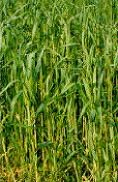Triticum x aestivum
Wheat, Trigo
Temperate
Introduction
The domestication of wheat, and its close relative barley, some 10,000 years ago along stream banks in the Middle East marked the start of agriculture and the end of the good old days of casual hunting and gathering. Wheat is the seed of an annual grass that contains a sticky protein called gluten. Gluten holds bread together. Wheat, sometimes called the Staff of Life, is generally considered to be the single most important human food plant.
The green leaves of the wheat plant are little utilized as human food, but are very nutritious just before seed formation begins. With a little experimentation it is possible to partially harvest leaves to dry and still get a good grain harvest from the same plants. For over 30 years there has been a small but enthusiastic demand for wheat grass juice and powdered wheat leaf products in the specialty health food market. Dried wheat leaf powder could and should become a much more important and much less expensive product than it is now.
Pros
- Well known, with a large number of varieties specifically bred for most conditions in the temperate and high altitude sub-tropics
- Can be grown as a vegetable, as a green manure crop, as an animal fodder, or as a grain
- Excellent source of chlorophyll, fiber, beta-carotene, calcium, iron, and vitamin K
- Good source of vitamin C, vitamin B-6 (pyridoxine), folic acid, and trace minerals
- Can be grown over the winter in much of the temperate zone, so that it doesn't need to displace other crops. This gives very early greens in the spring.
- Seed is very inexpensive
- Can be grown in pure stands with few weeds or insect pests
- Easy to harvest and easy to dry
- Relatively mild flavor of dried young wheat leaves makes it acceptable in a broader range of recipes than stronger flavored leaf powders
- Regrowth is fairly good after partial leaf harvest or light grazing
Cons
- Not suited to humid tropics
- Dried wheat leaves are about 35% fiber which is too high for children on a relatively high fiber diet.
- A heavy nitrogen feeder
- Wheat leaves are too stringy to eat without being dried and ground finely.
Notes
- Usually people who are allergic to wheat don't have any problem with eating wheat leaves. The allergic reaction is usually to gluten, a seed protein not present in the wheat leaves.
- Like most plant leaves, wheat leaves reach their nutritional peak just before the plant begins transferring nutrients from the leaves to the reproductive system for creating seeds. Spring wheat takes about a month to do this, and winter wheat more like six to eight months depending on the severity of the winter.
- Wheat leaves did exceptionally well in trials to extract leaf protein or leaf concentrate. It is an excellent source for leaf concentrate production in the temperate zones.
Seeds
- Wheat seed that is appropriate for your region can usually be obtained in bulk from a local farm supply store. Seeds for some wheat varieties of historical interest are available from Bountiful Gardens Seeds 18001 Shafer Ranch Rd. Willits, CA 95490 USA
Related Plants with Edible Leaves
Hordeum vulgare (barley)
